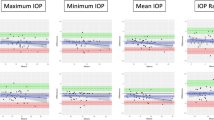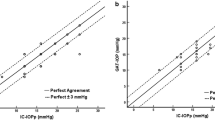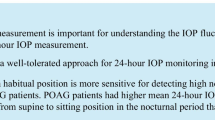Abstract
Purpose
The aim of this paper was to study the correlation and agreement between the intraocular pressure (IOP) peak value and fluctuations detected with the modified diurnal tension curve (mDTC) and the water drinking test (WDT) in pseudoexfoliation glaucoma (XFG) patients.
Methods
This prospective observational study enrolled 42 eyes of 42 XFG patients. The IOPs were measured at 2-h intervals from 8 am to 4 pm with a Goldmann applanation tonometer by a single observer to establish the mDTC. The WDT was then performed between 4 and 5 pm on the same day and the IOP was measured 4 times at 15-min intervals after water ingestion. The IOPpeak, IOPmean, IO min, and IOPfluctuation were measured with both the mDTC and WDT. The paired sample t test, Spearman's correlation coefficient and Bland–Altman plots were used for statistical analysis.
Results
The mean age of the 42 patients consisting of 24 females and 18 males was 66.9 ± 6.8 years, and the mean central corneal thickness was 517.7 ± 29.1 µm. The mean values with the mDTC and WDT measurements were 15.05 ± 2.75 mmHg and 17.17 ± 3.25 mmHg (p ≤ 0.0001, r = 0.884) for IOPmean, 16.76 ± 3.45 mmHg and 18.92 ± 3.94 mmHg (p ≤ 0.0001, r=0.787) for IOPpeak, and 13.61 ± 2.56 mmHg and 15.11 ± 2.84 mmHg (p ≤ 0.0001, r=0.824) for IOPmin, respectively, and a positive correlation was present between these values.
Conclusion
There was a positive correlation between the peak, minimum, and mean IOP values determined using the mDTC and WDT in treated XFG patients. WDT can be used as an alternative in the assessment of the IOP in these patients as a more practical method.



Similar content being viewed by others
References
Topouzis F, Harris A, Wilson MR, Koskosas A, Founti P, Yu F, Anastasopoulos E, Pappas T, Coleman AL (2009) Increased likelihood of glaucoma at the same screening intraocular pressure in subjects with pseudoexfoliation: the Thessaloniki Eye Study. Am J Ophthalmol 148(4):606–613
Konstas AG, Quaranta L, Mikropoulos DG, Nasr MB, Russo A, Jaffee HA, Stewart JA, Stewart WC (2012) Peak intraocular pressure and glaucomatous progression in primary open-angle glaucoma. J Ocul Pharmacol Ther 28(1):26–32
Konstas AG, Kahook MY, Araie M, Katsanos A, Quaranta L, Rossetti L, Holló G, Detorakis ET, Oddone F, Mikropoulos DG, Dutton GN (2018) Diurnal and 24-h intraocular pressures in glaucoma: monitoring strategies and impact on prognosis and treatment. Adv Ther 35(11):1775–1804
Danesh-Meyer HV (2008) The water-drinking test: the elegance of simplicity. Clin Experiment Ophthalmol 36(4):301–303
Vasconcelos de Moraes CG, Susanna R Jr (2008) Correlation between the water drinking test and modified diurnal tension curve in untreated glaucomatous eyes. Clinics 63(4):433–436
Kumar RS, de Guzman MH, Ong PY, Goldberg I (2008) Does peak intraocular pressure measured by water drinking test reflect peak circadian levels? A pilot study Clin Experiment Ophthalmol 36(4):312–315
Mocan MC, Kasim B, Muz E, Irkec M, Orhan M, Karabulut E, Mikropoulos DG, Konstas AG (2016) Intraocular pressure characteristics of exfoliative glaucoma and exfoliation syndrome as determined with the water drinking test. J Glaucoma 25(3):301–305
Ozyol E, Ozyol P, Karalezli A (2016) Reproducibility of the water-drinking test in patients with exfoliation syndrome and exfoliative glaucoma. Acta Ophthalmol 94(8):e795–e798
Kocatürk T, Bekmez S, Katrancı M, Çakmak H, Dayanır V (2015) Long term results of visual field progression analysis in open angle glaucoma patients under treatment. Open Ophthalmol J 9(1):116–120
Arora T, Bali SJ, Arora V, Wadhwani M, Panda A, Dada T (2015) Diurnal versus office-hour intraocular pressure fluctuation in primary adult-onset glaucoma. J Optom 8(4):239–243
Bhartiya S, Wadhwani M, Rai O, Patuel M, Dorairaj S, Sirish KN (2019) Diurnal variation of iop in angle closure disease: are we doing enough? Rom J Ophthalmol 63(3):208–216
Fogagnolo P, Orzalesi N, Ferreras A, Rossetti L (2009) The circadian curve of intraocular pressure: can we estimate its characteristics during office hours? Invest Ophthalmol Vis Sci 50(5):2209–2215
Mosaed S, Liu JHK, Weinreb RN (2005) Correlation between office and peak nocturnal intraocular pressures in healthy subjects and glaucoma patients. Am J Ophthalmol 139(2):320–324
Barkana Y, Anis S, Liebmann J, Tello C, Ritch R (2006) Clinical utility of intraocular pressure monitoring outside of normal office hours in patients with glaucoma. Arch Ophthalmol 124(6):793–797
Hughes E, Spry P, Diamond J (2003) 24-hour monitoring of intraocular pressure in glaucoma management: a retrospective review. J Glaucoma 12(3):232–236
Leske MC, Heijl A, Hyman L, Bengtsson B, Dong L, Yang Z (2007) Predictors of long-term progression in the early manifest glaucoma trial. Ophthalmology 114(11):1965–1972
The AGIS Investigators (2000) The advanced glaucoma intervention study (AGIS): 7 the relationship between control of intraocular pressure and visual field deterioration. Am J Ophthalmol 130(4):429–440
Susanna R Jr, Clement C, Goldberg I, Hatanaka M (2017) Applications of the water drinking test in glaucoma management. Clin Ophthalmol 45(6):625–631
Susanna R Jr, Vessani RM, Sakata L, Zacarias LC, Hatanaka M (2005) The relation between intraocular pressure peak in the water drinking test and visual field progression in glaucoma. Br J Ophthalmol 89(10):1298–1301
Vasconcelos de Moraes CG, Susanna R Jr, Ritch R (2011) The water drinking test. Am J Ophthalmol 151(3):559–560
Brubaker RF (2003) Targeting outflow facility in glaucoma management. Surv Ophthalmol 48(Suppl 1):17–20
Kocabeyoglu S, Uzun S, Kadayifcilar S, Mocan MC, Irkec M (2016) The relationship between choroidal expansion and intraocular pressure rise during the water drinking test in healthy subjects and patients with exfoliation syndrome. J Glaucoma 25(4):324–328
Goldberg I, Clement CI (2010) The water drinking test. Am J Ophthalmol 150(4):447–449
Babic M, De Moraes CG, Hatanaka M, Ju G, Susanna R Jr (2015) Reproducibility of the water drinking test in treated glaucomatous patients. Clin Exp Ophthalmol 43(3):228–233
Hatanaka M, Alencar LM, De Moraes CG, Susanna R Jr (2013) Reproducibility of intraocular pressure peak and fluctuation of the water drinking test. Clin Exp Ophthalmol 41(4):355–359
Othman TM, Abas AA, Elbably A, Mousa A (2020) Using the water drinking test as an alternative to modified diurnal tension curve in assessment of short-term intraocular pressure fluctuation Acta Scientific. Ophthalmology 3(2):05–11
Yoshikawa K, Inoue T, Inoue Y (1993) Normal tension glaucoma: the value of predictive tests. Acta Ophthalmol 71(4):463–470
De Moraes CG, Furlanetto RL, Reis AS, Vegini F, Cavalcanti NF, Susanna R Jr (2009) Agreement between stress intraocular pressure and long-term intraocular pressure measurements in primary open angle glaucoma. Clin Exp Ophthalmol 37(3):270–274
Malerbi FK, Hatanaka M, Vessani RM, Susanna R Jr (2005) Intraocular pressure variability in patients who reached target intraocular pressure. Br J Ophthalmol 89(5):540–542
Rasmussen KE, Jorgensen HA (1976) Diagnostic value of the water-drinking test in early detection of simple glaucoma. Acta Ophthalmol 54(2):160–166
Kerr NM, Danesh-Meyer HV (2010) Understanding the mechanism of the water drinking test: the role of fluid challenge in patients with medically controlled primary open angle glaucoma. Clin Experiment Ophthalmol 38(1):4–9
Hatanaka M, Grigera DE, Barbosa WL, Jordao M, Susanna R Jr (2008) An eight-week, multicentric, randomized, interventional, open-label, phase 4, parallel comparison of the efficacy and tolerability of the fixed combination of timolol 0.5%/brimonidine tartrate 0.2% versus fixed combination of timolol maleate 0.5%/dorzolamide 2% maleate in patients with elevated intraocular pressure. J Glaucoma 17(8):674–679
Vetrugno M, Sisto D, Trabucco T, Balducci F, Delle Noci N, Sborgia C (2005) Water drinking test in patients with primary open angle glaucoma while treated with different topical medications. J Ocul Pharmacol Ther 21(3):250–257
Danesh-Meyer HV, Papchenko T, Tan YW, Gamble GD (2008) Medically controlled glaucoma patients show greater increase in intraocular pressure than surgically controlled patients with the water drinking test. Ophthalmology 115(9):1566–1570
Armaly MF, Krueger DE, Maunder L, Becker B, Hetherington J Jr, Kolker AE, Levene RZ, Maumenee AE, Pollack IP, Shaffer RN (1980) Biostatistical analysis of the collaborative glaucoma study i summary report of the risk factors for glaucomatous visual-field defects. Arch Ophthalmol 98(12):2163–2171
Schlötzer-Schrehardt U, Naumann GO (2006) Ocular and systemic pseudoexfoliation syndrome. Am J Ophthalmol 141(5):921–937
Vesti E, Kivelä T (2000) Exfoliation syndrome and exfoliation glaucoma. Prog Retin Eye Res 19(3):345–368
Susanna R Jr, Sheu WP (2004) Latin American Glaucoma S. comparison of latanoprost with fixed-combination dorzolamide and timolol in adult patients with elevated intraocular pressure: an eight-week, randomized, open-label, parallel-group, multicenter study in Latin America. Clin Ther 26(5):755–768
Facio AC, Reis AS, de Vidal KS, Moraes CG, Suzuki R, Hatanaka M, Susanna R Jr (2009) A comparison of bimatoprost a comparison of bimatoprost 0.03% versus the fixed-combination of latanoprost 0.005% and timolol 0.5% in adult patients with elevated intraocular pressure: in adult patients with elevated intraocular pressure: an eight-week, randomized, open-label trial. J Ocul Pharmacol Ther 25(5):447–451
Hatanaka M, Reis A, Sano ME, Susanna R Jr (2010) Additive intraocular pressure reduction effect of fixed combination of maleate timolol 0.5%/dorzolamide 2% (Cosopt) on monotherapy with latanoprost (Xalatan) in patients with elevated intraocular pressure: a prospective, 4-week, open-label, randomized, controlled clinical trial. J Glaucoma 19(5):331–335
Krupin T, Liebmann JM, Greenfield DS, Ritch R, Gardiner S (2011) Low-pressure glaucoma study group low-pressure glaucoma study G. A randomized trial of brimonidine versus timolol in preserving visual function: results from the low-pressure glaucoma treatment study. Am J Ophthalmol 151(4):671–681
Funding
None.
Author information
Authors and Affiliations
Contributions
PF, SD, İTF, MF, SD (Demirel), EÖ, and ZG substantially contributed to the conception or design of the work; or the acquisition, analysis, or interpretation of data for the work, drafted the work or revised it critically for important intellectual content, finally approved the version to be published, and agree to be accountable for all aspects of the work in ensuring that questions related to the accuracy or integrity of any part of the work are appropriately investigated and resolved.
Corresponding author
Ethics declarations
Conflict of interest
All authors have no conflict of interest to declare.
Ethical approval
All procedures performed in the studies involving human participants were in accordance with the ethical standards of the institutional and/or national research committee and with the 1964 Helsinki declaration and its later amendments or comparable ethical standards.
Informed consent
Informed consent was obtained from all individual participants included in the study.
Additional information
Publisher's Note
Springer Nature remains neutral with regard to jurisdictional claims in published maps and institutional affiliations.
Rights and permissions
About this article
Cite this article
Firat, P.G., Dikci, S., Firat, İ.T. et al. Correlation between intraocular pressure obtained with water drinking test versus modified diurnal tension curve measurement in pseudoexfoliation glaucoma. Int Ophthalmol 41, 2879–2886 (2021). https://doi.org/10.1007/s10792-021-01847-5
Received:
Accepted:
Published:
Issue Date:
DOI: https://doi.org/10.1007/s10792-021-01847-5




